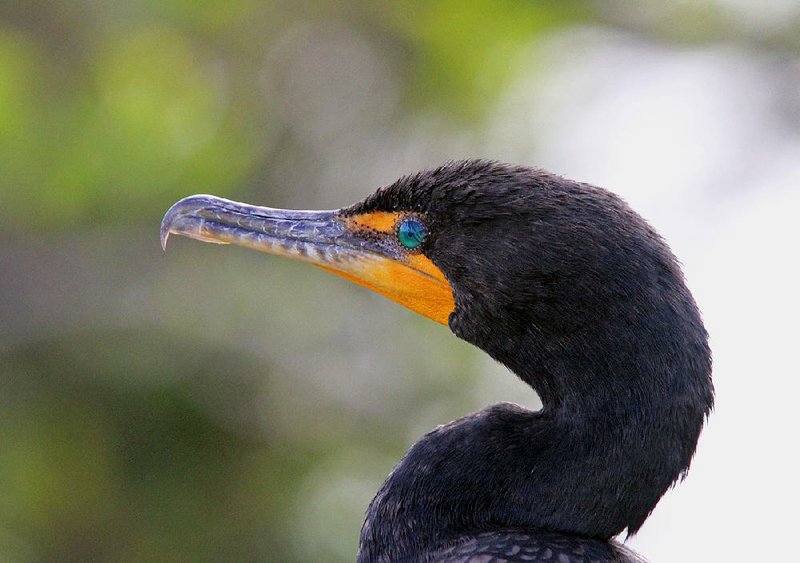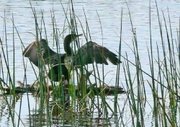The U.S. Fish and Wildlife Service lost a lawsuit this spring, resulting in the invalidation of "depredation orders" that allowed fish farmers to kill birds such as the double-crested cormorant if they are a threat to aquaculture, sport fishing or to natural resources.
"Cormorants don't come here for the sunshine and the hospitality," Margie Saul, who runs the Harry Saul Minnow Farm just west of DeValls Bluff, said recently. "They are here for our fish."
Bait fish and fry are a large part of Arkansas' multimillion dollar aquaculture industry, and this winter farmers are facing another aerial invasion.
Double-crested cormorants nest in states around the Great Lakes and in the northeast during the summer and fall and come south for the winter.
From 1998 until this spring, fish farmers in Arkansas and a dozen other states could kill limited numbers of double-crested cormorants and other birds that were deemed a threat. Similarly, state and and federal wildlife management agencies in 24 states have had the authority since 2003 to kill, without permits, double-crested cormorants and destroy their nests to save public resources.
Federal law requires the Fish and Wildlife Service to file either an environmental assessment or an environmental impact statement when it considers how a proposed action affects wildlife or the environment. The environmental impact statement is the more detailed, and more costly, of the two. The agency also must consider alternatives to any proposed action.
The Fish and Wildlife agency renewed the depredation orders in 2014, when it again said the double-crested cormorant population wouldn't be harmed if killing some was allowed.
But the agency did a cut-and-paste job, using the same data from its 2009 assessment for the 2014 assessment, U.S. District Judge John D. Bates in Washington, D.C., ruled this spring, siding with a group of former and current government employees called Public Employees for Environmental Responsibility.
"It seems that rather than take a 'hard look' at the impacts on cormorant populations ... FWS simply lifted the findings," the judge wrote.
Bates dismissed the agency's excuse of a lack of resources. "Allowing an agency to defend an [environmental assessment] on the ground that it lacks the resources to examine alternatives has the potential to eviscerate" federal law, Bates wrote.
He invalidated both depredation orders -- the one allowing fish farmers to take lethal action, and the one allowing state and federal wildlife agencies to do so, whether through killing cormorants outright or spraying their eggs with vegetable oil, suffocating them.
Curse birds
Few birds are as vilified as the cormorant.
In Paradise Lost, the English poet John Milton in 1671 had Satan disguised as a cormorant, sitting atop the Tree of Life in the Garden of Eden, when he first saw Adam and Eve.
The cormorant was nearly wiped out in the mid-1960s but made a comeback once the pesticide DDT was banned. The bird, and its eggs, also got a measure of protection in 1972 when it was placed under the Migratory Bird Treaty Act, which is 100 years old this year.
"Some states started to encourage cormorant breeding and, unfortunately, they got a little too successful," Mike Freeze, a co-owner of Keo Fish Farm in Lonoke County, said. His farm has 1,000 acres of bait fish.
Arkansas exports more than 6 billion bait fish nationwide annually -- some 80 percent of the U.S. market -- as part of the state's overall $170 million aquaculture industry. Arkansas also leads the nation in production of largemouth bass for stocker fish, hybrid striped bass fry and Chinese carp, according to the state Department of Agriculture.
The federal agency "should have had its numbers straight," Freeze said of the work overturned by the judge.
"The question now is how quickly can Fish and Wildlife get this straightened out and can they get it done by October when the birds start returning?" Freeze said. "They'll be here by the hundreds of thousands and stay until about March. At any one time this winter, I'll have a thousand, two thousand of them on and around my ponds."
A cormorant will eat a pound of fish per day. Having a thousand of them eating a pound of fish a day from $5 a pound to $100 a pound, depending on the species, adds up quickly, Freeze said. Commercial ponds may have up to 60,000 catfish per acre and up to 200,000 bait fish, according to the National Aquaculture Association.
About 35 miles to the northeast of Keo, as the cormorant flies, the Sauls' 1,200-acre minnow farm "is a smorgasbord for cormorants," Margie Saul said.
It is true, she said, that other birds feast on fish farms. "But other birds don't do near the damage simply because of the sheer number of cormorants," Saul said. She and her husband, James, and their son, William, run the farm, with another eight to 18 employees, depending on the season.
"There's no way to kill all the cormorants that come here, and that would never be our intent anyway," Saul said. "But killing a few is a tool that reinforces the other nonlethal measures we have. And now we don't have that tool."
Saul and Freeze agreed that cormorants are smart, but they do not credit them for much else.
No defense
Freeze said cormorants will herd fish into a corner of a pond and then start diving for them.
They also have grown resistant to nonlethal tools, such as propane cannons and "bird bangers" that can be timed to go boom throughout the day. The birds will be scared from one pond to the next only briefly.
Some cormorants won't be scared at all, Freeze said. "Those are the ones we want to shoot," he said. "If you don't move them off or kill them, they will be live decoys for other birds."
When cormorants start arriving, all fish farms have employees whose only jobs are to scare the cormorants away. They'll drive along the levees between ponds all day long, honking and waving. "They know our vehicles," Saul said. "They'll see a driver who's alone and they'll scatter over to the passenger side of the truck. We cannot let them get comfortable, even for our own lunch period."
Both Saul and Freeze realize that losing some fish -- to cormorants and other birds, or to turtles, snakes, minks and otters -- is a cost of doing business. "I can expect a 25 percent loss for those, but for the cormorant, if it's left unchecked, there will be losses of 80 percent, maybe 100 percent," Freeze said.
Some have suggested that fish farmers cover their ponds with nets to keep away predators.
It's not practical, Freeze said. Many ponds are the size of football fields or city blocks, and the levees aren't wide enough for the structural supports that would be needed.
Careful killing
Freeze pulled out his "bird logs" -- records that are required by the government -- to show a visitor recently. "It's not like they just turn us all loose with guns," he said. Shotguns are mostly used.
From January through March this year, Freeze's workers killed 226 double-crested cormorants. His permit allowed up to 400 kills. Fines are levied for going over the limit, or for underreporting kills.
"We killed 37 birds in 2015," he said. "That shows we did a very good job scaring them." Freeze then took a minute to rethink that. "That's not right. We had a lot of ice in 2015." Cormorants that find frozen fish farms keep flying south, Freeze said.
Cormorants hit fish farms during the day, then fly off to nearby cypress swamps, oxbow lakes or the Arkansas River to roost for the night. Their guano is highly acidic and kills off vegetation, especially cypress trees, Freeze said.
Arkansas once had about 65,000 acres devoted to aquaculture. It's half that now, he said, mainly because of an increase in the cost of feed and imports from Asia. That means cormorants have fewer ponds to concentrate on, and so they arrive at those ponds in even greater numbers, Freeze said.
The lawsuit against the U.S. Fish and Wildlife Service took particular aim at public hunts in South Carolina and Texas. Hunters in South Carolina killed nearly 12,000 double-crested cormorants in 2014 and nearly 15,000 the next year.
"No one in Arkansas is pushing for anything like that," Freeze said. His workers also are trained to know the difference between double-crested cormorants and birds that look similar such as the anhinga and the neotropic cormorant.
Balancing act
Thurman Booth, state director of the Animal and Plant Health Inspection Service, a division of the U.S. Department of Agriculture, said his agency's directive is to help promote agriculture in the U.S. and manage wildlife.
"We are hoping we are getting back into the business of helping fish farmers," Booth said. "We are still working with farmers on nonlethal devices, but we're also going to each farm to evaluate the minimum number of cormorants they could kill and save their fish, at least for this winter."
He will help farmers file what is called a Form 37, essentially a short-term permit to allow a certain number of kills, depending on the applicant's situation. Government officials will be required to visit each applicant's farm and assess situations there. The Form 37 permits weren't part of the Public Employees for Environmental Responsibility lawsuit.
"The judge suggested in his order that one solution would be to add double-crested cormorants to existing permits rather than having Wildlife Service reissue depredation orders," Booth said. "That would be a stop-gap measure that could help the farmer this winter."
Jeff Ruch, executive director of Public Employees for Environmental Responsibility, said individual permits to kill a limited number of double-crested cormorants "fit in" with the group's lawsuit against the Fish and Wildlife Service and the "barely regulated mass slaughter" of the birds.
"However, those permits should be based on actual harm, not on harm assumed that will happen months from now," Ruch said Wednesday. "That's really a concern. We'll be looking closely at those permits."
Freeze, the first Arkansas fish farmer to send in a Form 37, hadn't gotten a response from U.S. Fish and Wildlife Service as of Wednesday.
He also said that a few cormorants have already arrived. "This is really early," he said. "And that's troubling."
Booth said more trouble looms if depredation orders aren't reinstated in a year or two.
"It's not at all unlikely that we will have rookeries spring up in Arkansas," Booth said. "When that happens, we will have a significant population of cormorants in Arkansas year round. And then the hatred that fish farmers have for cormorants will greatly increase, and they will want to kill more cormorants. That will lead to an uprising of the bird activists, and the debate will be on."
SundayMonday Business on 09/04/2016

